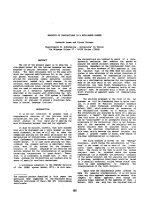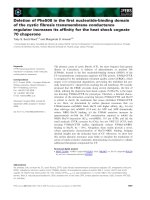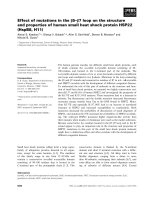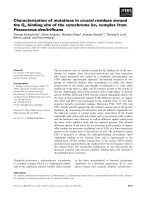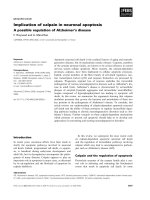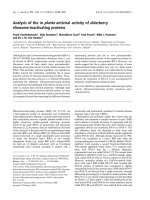Báo cáo khoa học: "Management of Calving in Norwegian CubicleHoused Dairy Herds" potx
Bạn đang xem bản rút gọn của tài liệu. Xem và tải ngay bản đầy đủ của tài liệu tại đây (68.2 KB, 7 trang )
Kjæstad HP, Simensen E: Management of calving in Norwegian cubicle-housed
dairy herds. Acta vet. scand. 2001, 42, 131-137. – Sixty of the 65 dairy farms with cu-
bicle houses in the Norwegian county of Oppland were included in a field study of the
management of calving in 1990. The farmers recorded the location of the cow when giv-
ing birth, farmer presence and whether assistance was given during calving, occurrence
of suckling, and time after birth when cow and calf were separated. Such data were re-
corded for a total of 1125 calvings. About 10% occurred on pasture, while 78% of the
remaining calvings took place in the cubicle-equipped section. Thirteen percent calved
in a calving pen, the remaining cows being tethered at the time of calving. Thirty-two
percent of the calvings took place in houses lacking a calving pen altogether. Farmers
were present during 41% of the calvings. Suckling most frequently occurred after pas-
ture calvings, and was least frequent after calvings within the cubicle-equipped section
of the cowhouse. Injuries to the calf caused by trampling or contact with fittings etc.
were rare, and no more common in association with calving in the cubicle-equipped sec-
tion than with calving taking place with the cow isolated from the rest of the herd. All
calves were removed from their dams within 24 h after birth.
dairy cow; cubicle housing; cubicle refusal; calving pen; management.
Acta vet. scand. 2001, 42, 131-137.
Acta vet. scand. vol. 42 no. 1, 2001
Management of Calving in Norwegian Cubicle-
Housed Dairy Herds
By H. P. Kjæstad and E. Simensen
The Norwegian School of Veterinary Science, Department of Large Animal Clinical Sciences, Oslo, Norway.
Introduction
Cubicle housing has become the predominant
way of keeping dairy cows in countries such as
the United Kingdom and the Netherlands, while
in Scandinavia tie-stall housing is still the most
common type of accommodation (Bøe 1993).
Cubicle housing can arguably be seen as an im-
provement to dairy cows’ welfare in several re-
spects (Schlichting & Smidt 1984). In Norway,
current regulations emphasizing the need to
give animals the opportunity to move about and
exhibit other forms of natural behaviour (The
Royal Ministry of Agriculture 1996) make it
likely that the proportion of cows being kept in
cubicle houses will continue to increase.
There are of course differences between the
management of calving in a cubicle house com-
pared to a tie-stall house. Two main options ex-
ist for dealing with the calving cow in cubicle
systems. One is to provide a separate calving
pen in which the cow is placed when calving is
imminent. The other option is to let the cow
calve in the cubicle-equipped section, i.e. in the
presence of the other cows in the herd. The lat-
ter practice gives rise to concerns regarding the
health and welfare of the new-born calf due to
chilling/soiling, and possible traumatic injury
due to contact with fittings, or injury from be-
ing trampled.
Based on the authors’ own observations, and
statements from farmers and veterinary practi-
tioners, it seems that many cows kept in cubicle
houses in Norway calve in the cubicle-equipped
section. However, no studies have been pub-
lished on how common this practice is, or
whether it is causing any problems. Therefore,
the main purpose of this study was to investi-
gate how calvings were managed in cubicle
houses.
Material and methods
All cubicle-housed herds within a predefined
geographical area, the county of Oppland, were
initially included in the study. Oppland county
was chosen because of its accessibility, and be-
cause it was known to have many dairy farms of
various sizes located in areas with varying to-
pography. All the 65 cubicle-housed dairy
farms in this county in 1990 were identified
with the help of the regional agricultural au-
thorities, the farming community, and veteri-
nary practitioners. The farmers concerned were
contacted and asked to participate in the study.
Three of the identified herds could not be in-
cluded in the study because the farmers did not
wish to participate, while one was excluded be-
cause of failure to record data and another for
stocking twice as many cows as there were cu-
bicles. The 60 herds included in the study were
visited before the calving season, the cow-
houses inspected and notes made of the type of
calving accommodation existing in the house.
At this time, the farmers were also instructed
how to record the following data on special
forms, using a separate form for each calving:
– Herd size (expressed by number of cow-
years)
– cow identity (name, number)
– calving date and calving number
– location favoured by the cow when lying
down during the last week before calving
(cubicle, alley, halfway inside cubicle, com-
binations, or unknown)
– location of the cow during the actual calving
(cubicle-equipped section, calving pen, tie
stall, pasture, or other location)
– specific location of the cow if calving took
place within the cubicle-equipped section
(cubicle, alley/dunging area, other site or un-
known)
– whether the birth was assisted
(no assistance at all, moderate traction ap-
plied, or assistance deemed to be absolutely
essential to deliver the calf)
– farmer presence during calving
(present during calving, present shortly after
calving -i.e. wet, recumbent calf, or present
only after calving -i.e. standing calf, dry coat)
– location of the calf in the cubicle-equipped
section when first seen by the farmer
(cubicle, alley, milking parlour, or other loca-
tion)
– how the calf was cleaned
(wiped by hand, licked by mother, combina-
tion or none of the options)
– injuries to the calf considered to be caused by
fittings, herd mates or the dam itself
(yes/no)
– time and date when the calf was separated
from its mother
– whether the calf had suckled before being
separated
(yes, no, or unknown)
– any remarks concerning the behaviour of
other cows while calving was taking place.
All farmers were contacted by telephone one to
two months after the calving season had started
to help sort out possible problems concerning
the recording of data. The herds were visited at
the end of the calving season to collect the
forms and review them in collaboration with
the farmers.
Results
Data were collected on altogether 1125 calv-
ings which took place on the 60 farms included
in the study. The median number of forms re-
turned by the farmers was 17, and the median
number of cow-years was 18 (range 11-109).
132 H. P. Kjæstad & E. Simensen
Acta vet. scand. vol. 42 no. 1, 2001
All cows were of the Norwegian Red Cattle
breed. First calving heifers comprised 36 % of
these, cows expecting their second calf and up
comprised 64%. Twenty farms lacked a separ-
ate calving pen. Thirty-two percent (358) of all
calvings took place on these farms. Most of the
calvings took place from July throughout Octo-
ber, 1990.
About 10% (103) of all recorded calvings took
place on pasture. The rest of the cows gave birth
indoors. Of these, 78% (786) calved in the cu-
bicle-equipped section in the presence of the
other cows, while 13% took place in a separate
calving pen. The remaining calvings took place
after the cows were individually tethered.
Most of the cows were cubicle users before
calving (97%), and while this proportion still
was high during calving, it was somewhat lower
(83%). The first calving heifers showed a much
lower level of cubicle use than the older cows,
the corresponding figures being 29% and 34%
respectively. Observations on both cubicle use
during the last week before calving as well as
during calving existed for 676 individual ani-
mals. The choice of calving location was rela-
tively consistent with the behaviour during the
last week before calving, but there was a certain
amount of behaviour change also, and this
change was associated with the initial behavi-
our: The probability of changing lying location
between the first observation (before calving)
and the other (during calving) was greater if the
first observation was cubicle refusal (OR=2.0,
c.i.
95%
=1.1-3.4).
Information on the location of the calf when
first seen by the farmer was provided in 623 of
the 786 instances when calving occurred in the
cubicle-equipped section. The most common
locations within the section were the alley
(76%), or a cubicle (21%). In 1% of the cases,
the calf was found in the pit of the milking par-
lour, while the remaining 2% were located else-
where. Of the calves that were found in a cubi-
cle, 24 % were considered new-born (they were
recumbent and their coats were still wet).
Answers to the question regarding physical in-
jury to the new-born calf, caused by the dam or
other cows, (e.g. due to butting or trampling), or
cowhouse fittings, were received for 1019 of the
calves, 765 of them born within the cubicle-
equipped section, the rest in a separate calving
pen or tie stall. Physical injuries to calves born
in the cubicle-equipped section were reported
in 1.3% of cases, the corresponding figure for
the other group being 1.4%.
Data on farmer presence and whether assis-
tance was given during calving was available
for 1120 calvings. At 72% of these, no assis-
tance was given at all, assistance being deemed
to be absolutely essential in only 8% of cases.
The farmer was present at 41% of the calvings.
All calves, including those born in a separate
Management of calving 133
Acta vet. scand. vol. 42 no. 1, 2001
Table 1. Suckling in relation to calving location.
Calving location n
Calf reportedly
suckled (%)
RR* c.i.
95%RR
chi square P
Cubicle section of house 654 17 0.4 0.3-0.5 <0.001
Calving pen 121 43 1.0 - -
Tie-stall 79 30 0.7 0.5-1.0 0.073
Pasture 85 69 1.6 1.3-2.1 <0.001
Other 6 20 - - -
Information for one or both variables in 178 cases either not provided by farmer or indicated as “unknown” on questionnaire.
*Relative “risk” of suckling in this location compared to calving pen.
pen, were removed from their dams within 24
hours after birth. Sixty-eight percent of the
calves were reported not to have suckled their
mothers before being separated, 21% were re-
ported to have suckled, while 11% had an un-
known history in this respect. Suckling was re-
ported most frequently in connection with
calving on pasture. Suckling frequently oc-
curred also when calving had taken place in a
separate pen, but not as often as on pasture (Ta-
ble 1).
The extent to which licking behaviour was ob-
served showed a similar tendency as the obser-
vations of suckling, licking occurring most fre-
quently on pasture, followed by calving pen
(Table 2). A total of fifty-four percent of the
cows that calved indoors licked the calf.
Finally, some farmers in this study remarked
that certain cows reacted to others calving by
vocalising loudly, and that “stealing” of calves
by recently calved cows was common.
Discussion
Using the farmers as observers instead of spe-
cially trained individuals enabled us to study
many herds and obtain a large amount of data
on individual calvings. In order to achieve an
acceptable level of observation reliability, the
data recording process was standardized by
making the observation categories in this study
as unambiguous and self-evident as possible.
The median number of forms completed for
each herd approximated the median herd size,
indicating that the response rate was high.
A relatively large proportion of the houses were
not fitted with a separate calving pen. Despite
the fact that 767 calvings occurred in houses
which were fitted with pens, only about 140
calvings took place inside them. This shows
that their use was relatively infrequent. The
common calving management practice of let-
ting the cows calve in the cubicle section of the
house, and not in a separate calving pen, was
not in conflict with any official code or regula-
tion at the time when the study was performed.
Nevertheless, the observed practice was not in
accordance with the intentions of those who de-
sign cubicle houses, recommending the use of a
calving pen (Agricultural University of Norway
1982). Official regulations have been amended
to require one calving pen per 25 cows (The
Royal Ministry of Agriculture 1996). Swedish
directives prescribe similar arrangements con-
cerning calving accommodation in dairy cubi-
cle housing (The Swedish Board of Agriculture
1995). The reasons for the farmers’ not using or
even installing a calving pen were not known,
but may have been small herd sizes, coupled
with seasonally concentrated calving in most
farms. The first factor would make the installa-
tion of a special pen relatively costly, while the
second would mean that it would be difficult to
134 H. P. Kjæstad & E. Simensen
Acta vet. scand. vol. 42 no. 1, 2001
Table 2. Calf cleaning after birth in relation to calving location.
Calving location n Licked by dam (%) RR* c.i.95%RR chi square P
Cubicle section of house 770 53 0.8 0.7-1.0 0.015
Calving pen 130 65 1.0 - -
Tie-stall 87 50 0.8 0.6-1.0 0.026
Pasture 94 90 1.4 1.2-1.6 < 0.001
Other 7 14 - - -
Information for one or both variables in 37 cases either not provided by farmer or indicated as “unknown” on questionnaire.
*Relative “risk” of being licked by dam in this location compared to calving pen.
accommodate all calving cows in a pen even if
one had been available. A majority of the calv-
ings therefore took place in the cubicle-equip-
ped section.
Most of these cows chose to lie down in the
same place when calving as during the last
week before calving. Cows or heifers which did
not use cubicles before calving generally did
not use cubicles during calving either. This
agrees with the results of other studies indicat-
ing that refusal to use cubicles is a relatively
consistent type of behaviour (Kjæstad & Myren
2001, O’Connell et al. 1993). Nevertheless,
there was also a considerable number of ani-
mals which did not choose the same lying loca-
tion. A number of cows which used cubicles be-
fore calving calved in the alley. One possible
explanation of this finding may be that some of
the adult, pregnant cows are too large to assume
a comfortable calving position (lateral or semi-
lateral recumbency) inside a cubicle. However,
the analysis of lying locations showed that the
significant trend for behaviour change was from
cubicle refusal to cubicle use, not vice versa.
This finding may reflect a general tendency for
generally increasing cubicle use, i.e. an effect
of time. Another possible interpretation is that
the cubicles on average provide a more attrac-
tive calving accommodation, for instance a
solid lying surface and more seclusion than
what is found in the alley area.
A few cows calved after being tethered. They
were accustomed to a certain freedom of move-
ment, and it is not known if or how such restric-
tion influenced their behaviour and welfare.
As regards the few calvings which took place in
a calving pen, there was relatively good oppor-
tunity to allow the calf to remain with its dam
for the first few days. We had therefore antici-
pated that some of the farmers would practice
keeping cow and calf together. This did not
prove to be the case as all calves born in pens
were also separated from their mothers within
the first 24 hours after birth. This is, however, in
accordance with traditional practice in Norwe-
gian dairy husbandry.
Keeping cow and calf together is thought to
have several positive effects, such as an in-
creased growth rate of the calf (Krohn & Mad-
sen 1985, Metz 1987) and higher milk yield and
feed intake by the cow (Krohn & Madsen
1985). It has also been suggested that absorp-
tion of colostrum immunoglobulins by the calf
is enhanced when the dam is present (Selman et
al. 1971, Smith et al. 1967), potentially increas-
ing the calf’s resistance to infectious diseases.
In addition to having positive health effects, the
opportunity for the cow and calf to engage in
mother-offspring behaviour can be seen as a
welfare issue. This is reflected in a statement by
the Norwegian Committee on Agricultural Eth-
ics, recommending that cow and calf should be
allowed to spend three to five days together be-
fore being separated (The Royal Ministry of
Agriculture 1997). Similar provisions are in-
cluded in the Swedish regulations for ecologi-
cal dairy farming, which require that calves be
allowed to suckle during the colostrum period
(The certification organisation for organic pro-
duction 2000).
Calving in a separate pen was associated with
the highest incidences of licking and suckling
in the present study (Tables 1 and 2). This was
as expected due to the fact that there are fewer
distracting elements in this environment, and
the cow and calf can direct more attention to-
wards each other. It has been suggested that the
two principal functions of licking of the new-
born calf are physical stimulation of the calf
and establishment of a cow-calf bond (Lidfors
1994).
The occurrence of physical injury to the calf
within its first 24 h was low, and seemingly un-
related to calving environment. With the reser-
vations that these observations were made by
the stockmen themselves and not by veterinary
Management of calving 135
Acta vet. scand. vol. 42 no. 1, 2001
surgeons, and that calves were left to spend var-
ying times in the calving environment before
separation, the results suggest that calves born
in the cubicle section are not subject to exces-
sive aggression or trampling by other cows.
However, longer-term monitoring of clinical
disease such as pneumonia and enteritis was not
undertaken, so that we are not able to discuss
the occurrence of such disease in this study.
It has been reported that calves born in loose
housing with other cows present are likely to
follow and suckle other cows than their dams
(Edwards 1983, Illmann & Spinka 1993, Le-
wandrowski & Hurnik 1983). Ingestion of non-
colostrum milk by a new-born calf accelerates
closure of the intestinal epithelium, impairing
the absorption of macromolecules (Michanek et
al. 1990). Subsequently ingested colostrum im-
munoglobulins will therefore not be able to
pass into the calf’s blood. On the other hand,
should the cow so suckled be producing colos-
trum, i.e. itself recently parturient, there may
not be enough left for its own new-born calf
(Michanek et al. 1990). Furthermore, other
cows which themselves are close to calving
may show investigative or maternal behaviour
towards the calf, which may cause distress to its
dam. The remarks from the farmers in the
present study concerning maternal behaviour
by cows other than the dam towards new-born
calves are in accordance with the findings of
Edwards (1983) that such cows frequently
showed maternal, but occasionally also aggres-
sive, behaviour towards new-born calves in
group housing.
Although not addressed in the present study,
calving in a separate pen may also be better for
the health of the cow. For example, supervision
of calving is easier, and any complication or as-
sociated disease can be dealt with more quickly
and effectively than in the cubicle-equipped
section. Tending to recuperating patients, such
as turning a paretic cow regularly from one side
to the other, is also facilitated in the calm and
quiet environment provided by a separate pen.
Furthermore, a separate calving pen is easier to
keep dry and clean, and provision of a soft,
well-littered surface makes it easier for the cow
and calf to get up and lie down.
The present study confirmed our general per-
ception that the majority of calvings in cubicle
house accommodation occur in the cubicle-
equipped section. The study also showed that
parturient cows normally prefer to lie down in a
cubicle when in labour, and that switching from
lying in alley the last few days of pregnancy to
cubicle use during calving is more likely than
the opposite switch. The management practice
found in the study did not seem to be associated
with traumatic injury to the calf, the occurrence
being about the same for calves born in the cu-
bicle-equipped section as for those born in a
separate calving pen. Finally, it is clear that sep-
arating cow and calf within 24 h after birth is a
common practice in Norwegian cubicle-housed
herds, even when calving has taken place in a
separate calving pen.
Acknowledgement
This study was funded by the Norwegian Research
Council. The authors also want to thank Dr. Arne
Flåøyen and Dr. Olav Østerås for their assistance in
preparing the manuscript.
References
Agricultural University of Norway: Innredninger og
teknisk utstyr for små løsdriftsfjøs (Fittings and
technical equipment for small cubicle houses).
Nordiske Jordbruksforskeres Forening Report
no. 9 , Ås 1982.
Bøe K: Synspunkter på adferd og produksjon hos
melkekuer i løsdrifts- og båsfjøssystemer (Views
on behaviour and production by dairy cows in
non-confinement housing and tethering systems).
ITF Report 28, Agricultural University of Nor-
way, Ås 1993.
Edwards SA: The behaviour of dairy cows and their
newborn calves in individual or group housing.
Appl. Anim. Eth. 1983, 10, 191-198.
136 H. P. Kjæstad & E. Simensen
Acta vet. scand. vol. 42 no. 1, 2001
Illmann G, Spinka M: Maternal behaviour of dairy
heifers and suckling of their newborn calves in
group housing. Appl. Anim. Behav. Sci. 1993,
36, 91-98.
Kjæstad HP, Myren HJ: Failure to use cubicles and
concentrate dispenser by heifers after transfer
from rearing accommodation to milking herd.
Acta Vet. Scand. 2001, 42, 171-180.
Krohn CC, Madsen KK: Undersøgelser vedrørende
ko-kalv samspil (Investigations concerning cow-
calf interaction). 1. Indflydelse af 10 dages patte-
periode på koens mælkeydelse, yversundhed og
reproduksjon samt på kalvens tilvækst og livs-
kraft. Communication no. 586 from Statens Hus-
dyrbrugsforsøg, København 1985.
Lewandrowski NM, Hurnik JF: Nursing and cross-
nursing behaviour of beef cattle in confinement.
Can. J. Anim. Sci. 1983, 63, 849-853.
Lidfors L: Mother-Young Behaviour in Cattle. Partu-
rition, development of cow-calf attachment,
suckling and effects of separation. Thesis, Swed-
ish University of Agricultural Science, Uppsala
1994.
Metz JHM: Productivity aspects of keeping cow and
calf together in the post-partum period. Livestock
Prod. Sci. 1987, 16, 385-394.
Michanek P, Ventorp M, Westrøm B: Milk intake be-
fore first colostrum in newborn dairy calves. Ef-
fect on intestinal transmssion of macromole-
cules. J. Dairy Sci. 1990, 73, 480-483.
O’Connell JM, Giller PS, Meaney WJ: Weanling
training and cubicle usage as heifers. Appl.
Anim. Behav. Sci. 1993, 37, 185-195.
Schlichting MC, Smidt D: Versuch einer ethologis-
chen Bewertung von Milchviehhaltungssyste-
men. KTBL-Schrift 1984, 307, 72-78.
Selman IE, McEwan AD, Fisher EW: Studies on
dairy calves allowed to suckle their dams at fixed
times post partum. Res. Vet. Sci. 1971, 12, 1-6.
Smith HW, O’Neal JA, Simmons EJ: The immune
globulin content of the serum of calves in Eng-
land. Vet. Rec. 1967, 80, 664-666.
The certification organisation for organic production
-KRAV: Kravregler (regulations of KRAV). Upp-
sala 2000.
The Royal Ministry of Agriculture: Forskrifter om
hold av produksjonsdyr (Regulations concerning
the keeping of production animals). Oslo 1996.
The Royal Ministry of Agriculture: Skille av melkeku
og kalv etter fødselen. Uttalelse fra Rådet for Dy-
reetikk (Separation of dairy cow and calf after
birth. Statement from the Council for Animal
Ethics), Oslo 1997.
The Swedish Board of Agriculture: Djurskyddsbe-
stämmelser (Animal protection regulations).
Jordbruksinformation 10, Jönköping 1995.
Sammendrag
Stellrutiner omkring kalving i norske løsdriftsfjøs.
Denne studiens formål var å undersøke stellrutiner
omkring kalving i norske løsdriftsfjøs for melkekyr.
Seksti av de i alt 65 melkekubesetningene med løs-
drift i Oppland fylke i 1990 inngikk i en feltstudie der
bonde/røkter selv noterte observasjoner på et eget
skjema, bl.a. registrerte en hvor i fjøset hver ku kal-
vet, eventuell forekomst av amming samt tid inntil
mor og kalv ble skilt. I alt 1125 kalvinger ble doku-
mentert på denne måten. Trettito prosent av alle kal-
vingene skjedde i fjøs som ikke var utstyrt med en
egen kalvingsbinge. Av de kalvingene som foregikk
innendørs, dvs. ikke på beite, fant 78% sted i
løsdriftsarealet. Tretten prosent skjedde i en egen kal-
vingsbinge, mens resten av kyrne var bundet ved
kalving. Bonden var selv til stede under 4% av
fødslene. Det var få tilfeller av fysisk skade på den
nyfødte kalven som kunne tilskrives kontakt med an-
dre kyr eller med innredningen. Det forekom relativt
ofte at kyrne fikk slikke og amme kalvene, men ku og
kalv ble alltid skilt innen 24 timer etter kalving, også
når kalven var født i kalvingsbinge.
Management of calving 137
Acta vet. scand. vol. 42 no. 1, 2001
(Received August 3, 2000; accepted October 8, 2000).
Reprints may be obtained from: H. P. Kjæstad, Department of Large Animal Clinical Sciences, P.O. Box 8146
dep., 0033 Oslo, Norway. E-mail: , tel. +47 22 96 49 56, fax: +47 22 96 47 61.
